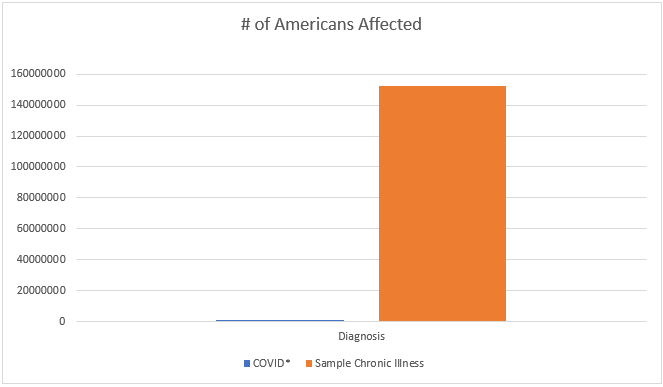As an employer, it can be difficult to balance the desire to return to business and maintain a safe operation. Unfortunately, there’s not necessarily an exact answer as to how to approach reopening your business during a pandemic. While there are some rules and regulations, many details can be unclear or depend on your location, the nature of your business, and a plethora of other reasons. To help, we broke down some key factors you should consider when it’s time to reopen your business or expand operations.

Is My Region Ready for My Business to Reopen?
It’s important to identify if your community is in a good position before you attempt to reopen your business. The White House’s Guidelines for Opening Up America Again recommends a phased approach to reopening businesses to help slow the spread of COVID-19. These guidelines suggest a few general state or regional criteria for relaxing restrictions based on certain factors within your community.
- There should be a downward trajectory of both influenza-like illnesses (ILI) and COVID-like syndromic cases reported within a 14-day period.
- There should be either a downward trajectory of documented cases within a 14-day period or a downward trajectory of positive tests as a percent of total tests within a 14-day period (flat or increasing volume of tests).
- Regional hospitals should be able to treat all patients without crisis care
- There should be a robust testing program in place for at-risk healthcare workers, including emerging antibody testing.
While the factors listed above are solid guidelines for a safer return, it’s important to note that these are not mandates. Each state is able to independently manage COVID-19 regulations, so you’ll need to double-check local laws and rulings for any specific regulations.
The Three Phases for Reopening Your Business
If your state does allow for your business to reopen, consider taking a multi-phase approach to resuming operations. This method can help you reopen your business in different stages to help keep you, your employees, and your clientele safe while you get back to business.
Phase one
The first phase focuses on making telework available to any employees who do not need to be onsite to complete their duties. If you maintain a regular place of business, you should close off any common areas to prevent anyone other than employees who must be on location. In addition to allowing for remote work, businesses in phase one should also minimize nonessential travel.
Phase two
After going through phase one long enough for another two-week decline in cases, guidelines indicate that businesses can shift to phase two. Businesses should have an accommodation plan for vulnerable employees in place at this point.
Employees who cannot work from home are allowed to return to the workplace as long as they follow proper safety protocol. Social distancing measures must be enforced, but businesses can ease limitations on the number of people in a space.
Phase three
Advancement to phase three requires another two-week decline in cases at the previous stage. Once in phase three, employers can resume unrestricted staffing of worksites. However, businesses in this phase should maintain social distancing guidelines where possible and are recommended to approach public interaction very carefully.
What to Address When Reopening Your Business
When it’s time to return to work, it’s important to weigh many factors that can impact you and your employees. According to the CDC, any plan to reopen your business should meet the following criteria:
- Be specific to your workplace.
- Identify all areas and job tasks with potential exposures to COVID-19.
- Include control measures to eliminate or reduce such exposures.
To meet these standards, you’ll need to address some key elements before you reopen your business.
Hazard assessment
As you plan for a return to work, it’s critical to assess potential hazards to you and your employees and take measures to help prevent the spread of COVID-19 in the workplace. The following practices can help you identify potential risk factors and keep your workforce safe.
A thorough hazard assessment should be completed before any employees return to work on company premises. Various locations and job duties can create hazards specific to your business. It’s imperative to pinpoint potential problem areas and determine what can be done to protect people in those positions. The CDC suggests using the following hierarchy of controls to implement feasible and effective control solutions.
- Elimination – Physically remove the hazard
- Substitution – Replace the hazard
- Engineering controls – Isolate people from the hazard
- Administrative controls – Change the way people work
- PPE – Protect the worker with Personal Protective Equipment
This hierarchy represents the most to least effective means of eliminating exposure risks in the workplace. For example, if a specific hazard forced employees to work in close quarters, the removal of that hazard is the most effective way to eliminate the risk. Of course, elimination or substitution isn’t always practical or even feasible. Instead, use the hierarchy to identify the best, most realistic method to lessen exposure risks and enact those preventative measures.
Social distancing measures
One effective control solution is to enable practices that help employees and potential clientele to maintain a safe distance during work. Six-foot spacing is the expected standard, so consider the following steps to promote social distancing standards in the workplace.
- Post signage that everyone – employees, customers, and visitors included – should maintain at least a six-foot distance from each other.
- Add directional signs for hallways and other spaces where six-foot spacing restricts movement.
- Mark floors, counters, and more with tape or signs to create clear spaces for where employees and/or customers should stand to maintain social distancing.
- Limit occupancy to help provide additional space for employees, customers, and visitors to prevent overcrowding and improper distancing.
- Implement teleworking capabilities to allow people to work from home
- Modify the work area to create more physical space between employees.
- Close certain spaces – such as common areas – where people congregate or are too small for social distancing measures.
Improve workplace hygiene
Once you’ve taken steps to assess potential exposure risks and enact social distancing measures, it’s time to identify ways to implement improved hygiene standards. There are a variety of practices that employers can enact to help maintain a healthy environment and keep workspaces clean.
- Keep soap, water, hand wipes, and paper towels available for employees, customers, and visitors to wash their hands.
- Encourage frequent hand washing and post instructions on how to properly wash hands at all sinks or other washing stations.
- Provide hand sanitizer – ideally with touchless dispensers – with at least 60 percent alcohol and stress to employees the importance of using it.
- Educate employees about proper CDC sneezing and coughing practices.
- Place no-touch trash cans and other receptacles around the premises.
- Prohibit handshaking.
- Discourage workers from using other employees’ desks, phones, supplies, and any other work tools and equipment.
- Identify high-traffic areas and commonly touched surfaces that require regular cleaning and disinfection.
- Routinely clean surfaces and higher-traffic areas in the workplace with an EPA-approved disinfectant.
Create practices to identify and address exposed or ill employees
Another key step toward reopening is to create a plan for employees affected by COVID-19. These policies should cover workers who may currently be sick or who show symptoms while at work.
Have sick employees stay home
If an employee may be sick – or live with someone who is sick – play it safe and have them stay away from work. Stress to employees that they should remain at home and notify their supervisor if they feel sick or have noticed any symptoms for COVID-19. Have employees evaluate themselves for potential symptoms before heading to work. In addition, provide them with a link to the CDC’s steps for individuals who may have COVID-19. These employees should stay away from work until they or their family members meet the CDC’s guidelines to discontinue home isolation and are cleared by a healthcare professional.
Consider conducting daily in-person or virtual health checks
One way to help limit potential exposure is to conduct site temperature checks, symptom questionnaires, or other forms of health screening while at work. Neither the OSH Act nor OSHA standards prevent employers from testing employees for COVID-19 as long as this testing is done in a transparent, non-retaliatory manner.
Personnel who conduct these screenings should wear PPE or some other level of protection. It is also not necessary to make a record of temperature checks and other details – screeners can simply acknowledge readings then and there. If you choose to document these records, you’ll want to retain them and keep them confidential as you would any other document covered under the Access to Employee Exposure and Medical Records standard.
Separate sick employees and send them home
It’s critical to have a policy in place for any employees who fail a screening or become ill while in the workplace. This protocol should include details about how and where to isolate sick employees if they are unable to leave immediately. For employees who use public transportation or are otherwise unable to take themselves home or to a healthcare facility, have a procedure in place to provide them with safe transport.
Once the affected individual leaves, all spaces that person has touched or otherwise occupied should be cleaned and disinfected to prevent possible exposure to others. Use the CDC’s cleaning and disinfection recommendations to prepare areas for future use.
- Clean dirty surfaces with soap and water before disinfecting them.
- Disinfect surfaces with products that meet EPA criteria for use against SARS-Cov-2 and are appropriate for the surface.
- Always wear gloves and gowns appropriate for the chemicals being used when you are cleaning and disinfecting.
- Wear additional PPE depending on the setting and disinfectant product you are using. For each product you use, consult and follow the manufacturer’s instructions for use.
Create a return to work policy for workers who dealt with illness or exposure
Make sure to have some guidelines in place before an employee returns to company premises after isolation. To start, employees should use the following CDC recommendations to know when to discontinue isolation.
- At least 10 days have passed since symptom onset.
- At least 24 hours have passed since resolution of fever without the use of fever-reducing medications.
- Other symptoms have improved.
Once the affected employee is ready to return, have that employee routinely perform self-monitoring in addition to any workplace screenings required.
List and install various controls and safe work practices
Before you open back up for business, you should document and implement the different measures taken to protect employees from exposure in the workplace. These measures should include different engineering and administrative controls, safe work practices, PPEs, and other regulations.
Engineering controls for COVID-19
There are multiple engineering controls that can help isolate employees from potential work-related hazards. These controls typically involve improving or altering worksites to reduce the chances of exposure. Certain engineering controls are more feasible than others, but the following options can help you improve the overall safety of your business.
- Improve ventilation rates in working environments and disable demand-controlled ventilation (DCV).
- Install high-efficiency air filters.
- Keep ventilation systems running longer hours, perhaps even all day, to enhance air exchanges in the building space.
- Mount physical barriers such as clear plastic guard walls and sneeze guards between work stations, places with employee/customer interaction, and other spaces.
- Add a drive-through window or some other means of distancing for customer service.
- Move electronic payment reader away from cashier.
- Remove or rearrange furniture and other items to increase space and maneuverability.
- Review the safety of your building water system and devices after a prolonged shutdown.
Administrative controls
While engineering controls alter your work spaces, administrative controls are changes to work policies that impact employees. Adjusting certain procedures can help limit the odds of exposure and give employees not only a safer work environment, but also some peace of mind to allow them to focus on their jobs and personal lives. Consider instituting some of the following administrative controls when it’s time to return to work.
- Create communication plans and invest in online teleconferencing or chat platforms to give employees the means to communicate away from the office and address any concerns.
- Evaluate existing policies and, if needed, implement new ones that provide additional flexibility and use of telework, types of leave, and other options to help employees minimize exposure risks.
- Replace in-person meetings with virtual communications to minimize contact among employees, clients, and customers.
- Offer work hour flexibility, alternating days, or staggered shifts to limit the number of employees in the same location at the same time.
- Limit, or even discontinue, nonessential travel.
- Limit capacity for break rooms.
- Mandate employees wear cloth face masks and other appropriate face coverings if PPE is not required.
- Provide employees with up-to-date education on COVID-19 risk factors and training for protective behaviors, such as how to wear protective clothing, proper care, etc.
PPEs
As an employer, you are obligated to provide employees with the proper PPE required to keep them safe as they complete their duties. Gloves, goggles, face shields, face masks, and respiratory protection are all forms of PPE that may be required depending on an employee’s duties. Before you reopen your business, you should assess which PPE is required for every employee based on specific job duties and the hazards faced in that role. In addition, PPE should be provided at no cost to the employees. According to OSHA, the PPE supplied to your employees should be:
- Selected based upon the hazard to the worker.
- Properly fitted and periodically refitted, as applicable (e.g., respirators).
- Consistently and properly worn when required.
- Regularly inspected, maintained, and replaced, as necessary.
- Properly removed, cleaned, and stored or disposed of, as applicable, to avoid contamination of self, others, or the environment.
Don’t Prepare for the Future Alone
Running a successful business isn’t easy during normal times – figuring out how to safely reopen during a pandemic is a different challenge altogether. There are multiple factors that impact the ability to reopen your business in a safe and compliant manner, and only so much time for you and your team to determine the right course of action for your company.
While reopening your business is a frenzied experience, you don’t have to go through the process by yourself. At GMS, our experts can help guide you through difficult decisions and take the administrative burden off your shoulders as you lead your business through a critical endeavor. Contact GMS today to find out how we can help you make your business simpler, safer, and stronger.








